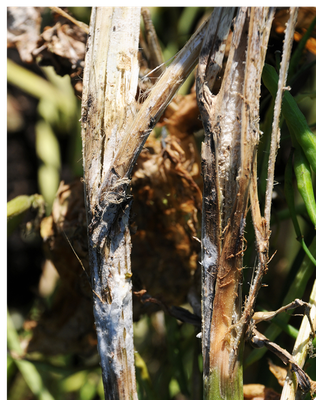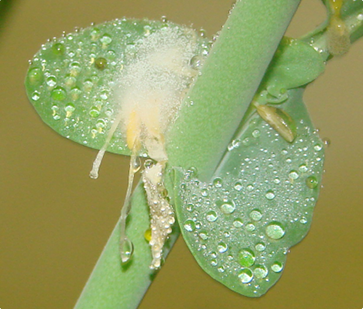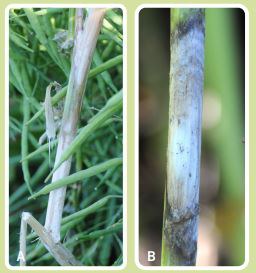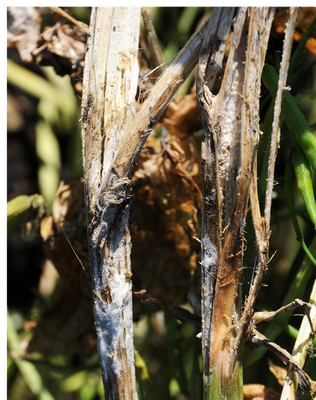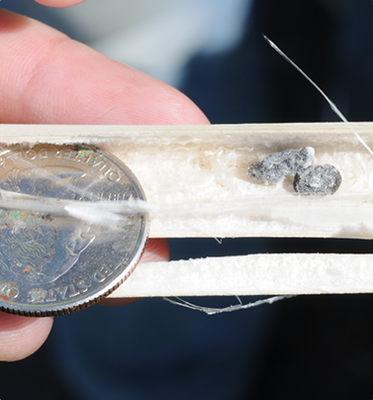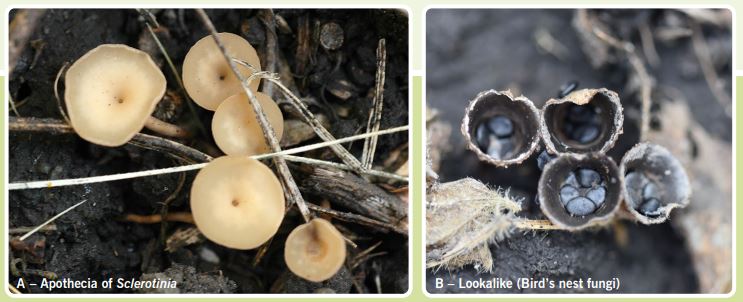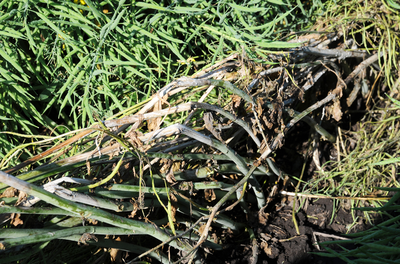The disease cycle begins when sclerotia germinate, typically in the early summer (second half of June). While many sclerotia may be incorporated into the soil during tillage, only sclerotia in the top 2 inches will germinate.
Continuous soil moisture for a minimum period of 10 days, accompanied by soil temperatures of 60 to 77 F, is required for germination. These conditions normally occur in mid to late spring when the canopy closes, often at the end of the rosette growth stage.
Sclerotia germinate to produce apothecia, small mushroomlike structures normally 0.2 to 0.4 inch in size; they resemble miniature golf tees or upside-down mushrooms. Apothecia (Figure 5A) easily can be mistaken for reproductive organs of a saprophytic fungus called “bird’s nest;” these fungi decompose the plant tissues in the soil and do not cause any plant diseases (Figure 5B).
Figure 5. Apothecia of Sclerotinia sclerotiorum (A) compared with bird’s nest fungi (B).
Once sclerotia germinate, apothecia will be produced within three to four weeks; however, if intermittent soil moisture conditions prevail, apothecia formation may take longer or be arrested completely. Fully formed apothecia release ascospores, the primary inoculum for the disease.
Ascospores can be carried by wind for long distances; however, most ascospores are deposited within 100 to 120 feet of the apothecia. While apothecia are difficult to find in a field (most easily observed where white mold was common in the previous year), their presence indicates that pathogen spores exist and the crop may be at risk.
The infection process begins when ascospores land on flower petals, where they germinate and grow. Notably, ascospores that land directly on other healthy plant tissues cannot infect plants.
From flower petals, the fungus grows into leaves, petioles, branches and stems. Once the pathogen penetrates the plant, it will colonize and feed on the plant tissues. Sclerotia will be formed inside or on the stem once the nutritional value of infected plant tissues has been exhausted or if environmental conditions become unfavorable for the fungus.
Temperature and moisture conditions during bloom are extremely important determinants for the establishment and development of Sclerotinia stem rot. Cool to moderate temperatures from 65 to 72 F are optimal for infection, and temperatures higher than 86 F will arrest the development of the disease temporarily.
Frequent and prolonged periods of free moisture (frequent rainfalls, heavy dews and fog) are equally critical for infection. If ascospores land on casted petals, they have a 50% chance of successfully developing a foliar lesion when a total of 48 hours of accumulated leaf wetness duration occurs in a period of six days (with average daily temperatures of 70 F).
If accumulated wetness increases to 66 hours, the probability of disease development increases to 70%. If dry weather before and during the flowering stage occurs, the likelihood of establishment and development of the disease is reduced.
Plant-to-plant transmission of the pathogen is relatively low but may occur when infected and healthy tissues are in direct contact. However, the amount of plant-to-plant transmission typically does not translate into economic yield reductions.
